Observation report
Dr. Shibahara's Vietnam Travelogue
Third Visit to Bach Mai Hospital, Hanoi
August 23 – 26, 200
Donation of Two Single-Patient Dialysis Machines (Nikkiso, DBB-26)
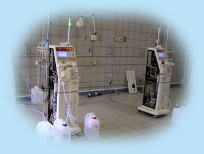 I conducted demonstrations of internal shunt surgery at Bach Mai Hospital, Hanoi in August 2004 and March 2006, but this time, on August 24, 2007, as a member of the Ubiquitous Blood Purification International (UBPI) NPO, I presented the Nephrology Department of Bach Mai Hospital with two single-patient dialysis machines (Nikkiso, DBB-26).
I conducted demonstrations of internal shunt surgery at Bach Mai Hospital, Hanoi in August 2004 and March 2006, but this time, on August 24, 2007, as a member of the Ubiquitous Blood Purification International (UBPI) NPO, I presented the Nephrology Department of Bach Mai Hospital with two single-patient dialysis machines (Nikkiso, DBB-26).
With a land area about 80% that of Japan, a population of around 83 million, a GDP per capita of 636 US dollars (2005 statistics, according to 2006 IMF report), and economic growth of 8.17% (in 2006), 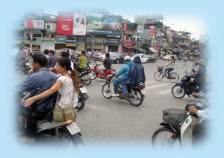 Vietnam is a truly developing nation. A significant number of Japanese companies have moved there in recent years due to its many Japanophiles and inexpensive workforce. Incidentally, Vietnamese workers in foreign companies earn about $500/month compared to about $200/month in domestic companies. My impressions on my third visit to Hanoi were that there were more cars driving around and parked on the streets, more women with a lighter complexion and brown hair and fewer wearing ao dai tunics, and increased street lighting.
Vietnam is a truly developing nation. A significant number of Japanese companies have moved there in recent years due to its many Japanophiles and inexpensive workforce. Incidentally, Vietnamese workers in foreign companies earn about $500/month compared to about $200/month in domestic companies. My impressions on my third visit to Hanoi were that there were more cars driving around and parked on the streets, more women with a lighter complexion and brown hair and fewer wearing ao dai tunics, and increased street lighting.
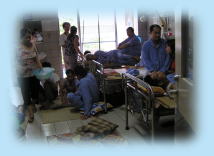 Bach Mai Hospital is a 2,000-bed hospital run by the Ministry of Health and affiliated to Hanoi Medical University. Previously I had only performed shunt surgery demonstrations at the hospital’s Hemodialysis Department, but this time I visited its Nephrology Department too for the first time. According to Dr. Dinh Thi Kim Dung, Head of the Nephrology Department, there are 50 beds for inpatients, 14 doctors, and approximately 10,000 outpatients and 1,200 inpatients per year. However, rather than one patient per bed, up to three men or four women were sharing a bed, and their family members slept overnight on the floor.
Bach Mai Hospital is a 2,000-bed hospital run by the Ministry of Health and affiliated to Hanoi Medical University. Previously I had only performed shunt surgery demonstrations at the hospital’s Hemodialysis Department, but this time I visited its Nephrology Department too for the first time. According to Dr. Dinh Thi Kim Dung, Head of the Nephrology Department, there are 50 beds for inpatients, 14 doctors, and approximately 10,000 outpatients and 1,200 inpatients per year. However, rather than one patient per bed, up to three men or four women were sharing a bed, and their family members slept overnight on the floor.
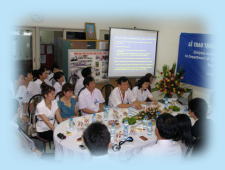
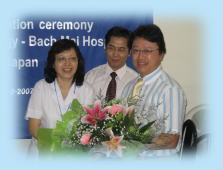 Our reasons for donating two single-patient dialysis machines (Nikkiso, DBB-26) to the Nephrology Department rather than the Hemodialysis Department were because the Hemodialysis Department already has 50 machines with sufficient funds whereas the Nephrology Department has none so has to transport its patients (12 to 20 per day) across the road, while squeezing their Ambu bags, to the dialysis ward at 1 am or 2 am, depending on availability, and because Dr. Dung is an extremely diligent woman.
Our reasons for donating two single-patient dialysis machines (Nikkiso, DBB-26) to the Nephrology Department rather than the Hemodialysis Department were because the Hemodialysis Department already has 50 machines with sufficient funds whereas the Nephrology Department has none so has to transport its patients (12 to 20 per day) across the road, while squeezing their Ambu bags, to the dialysis ward at 1 am or 2 am, depending on availability, and because Dr. Dung is an extremely diligent woman.
The presentation party was attended by around 30 people, including Dr. Tran Thuy Hanh, female Director of the Bach Mai Hospital, Dr. Ngo Quy Chau, Deputy Director of the Bach Mai Hospital (Respiratory Department, active during the SARS outbreak), Dr. Do Thi Lieu, Head of the Internal Medicine Department at Hanoi Medical University, and First Secretary and Medical Attache of the Embassy of Japan in Vietnam, Mr. Yasutaka Mizuno. After the self-introductions and discussions, we presented the two DBB-26 machines (Nikkiso), and this was followed by a visit to the Nephrology Ward and Hemodialysis Ward. (August 24, 2007)
*The State of Dialysis in Vietnam and Conditions in the Nephrology Department
The State of Dialysis
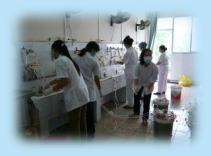 77,000 people are in need of dialysis but in fact only 2,500 are receiving treatment.
77,000 people are in need of dialysis but in fact only 2,500 are receiving treatment.
The cost of dialysis for people with an income and health insurance is $30 per time incurred by the government and nothing by the individual (60%), compared with $22 per time incurred by the government and nothing by the individual with no income or health insurance (40%). Although it was explained to us that dialyzers and circuits are reused four to eight times, it seems that in the case of low-income individuals dialyzers and circuits are reused until ripping and breaking.
6 treatments/day
QB 350 mL/min
Maximum 3.5 hours of dialysis
Blood test 4 times/year
Chest X-rays are not taken regularly. (They are taken after the onset of pneumonia or heart failure.)
There is an extra cost for erythropoietin, vitamin D, and calcium carbonate preparations.
Conditions in the Nephrology Department
The department handles cases of nephritis, acute kidney failure, implementation of dialysis, management of maintenance dialysis, kidney transplants, and CAPD.
It has no dialysis machines, so patients requiring dialysis (12-20 patients per day) are transported from the nephrology ward to separate building (hemodialysis ward) across the road.
The state of CAPD (done by Nephrology Department)
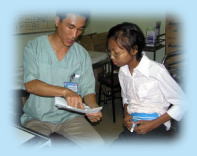 Cost is $500/day incurred by the government, nothing by the individual (reimbursed by health insurance since November 2004). Bags replaced 4 times/day. 180 patients initiated CAPD since November 2004, and the current number of patients is 130. Baxter has a monopoly.
Cost is $500/day incurred by the government, nothing by the individual (reimbursed by health insurance since November 2004). Bags replaced 4 times/day. 180 patients initiated CAPD since November 2004, and the current number of patients is 130. Baxter has a monopoly.
Our donation was welcomed by not only the Nephrology Department but also Bach Mai Hospital as a whole, and I had a good time at lunch meetings and dinner meetings too.
Finally, looking at our assistance for Vietnam going forward, there is enough space in the dialysis room of the Nephrology Department for another six single-patient dialysis machines, so we hope to continue our support in cooperation with Nikkiso Co., Ltd. Together with the Embassy of Vietnam in Japan, we also plan to apply to the Embassy of Japan in Vietnam for its grassroots grant assistance.
Nobuhisa Shibahara, Director
Arisawa General Hospital
